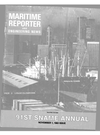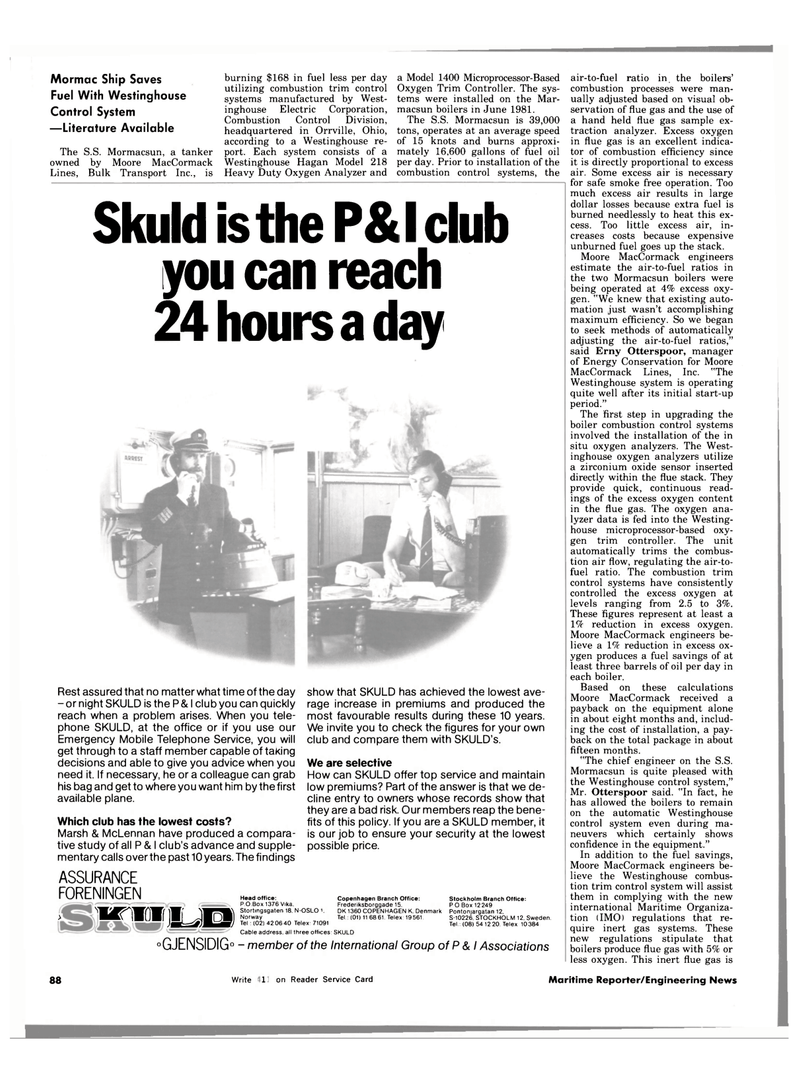
Page 84: of Maritime Reporter Magazine (November 1983)
Read this page in Pdf, Flash or Html5 edition of November 1983 Maritime Reporter Magazine
Mormac Ship Saves
Fuel With Westinghouse
Control System —Literature Available
The S.S. Mormacsun, a tanker owned by Moore MacCormack
Lines, Bulk Transport Inc., is burning $168 in fuel less per day utilizing combustion trim control systems manufactured by West- inghouse Electric Corporation,
Combustion Control Division, headquartered in Orrville, Ohio, according to a Westinghouse re- port. Each system consists of a
Westinghouse Hagan Model 218
Heavy Duty Oxygen Analyzer and a Model 1400 Microprocessor-Based
Oxygen Trim Controller. The sys- tems were installed on the Mar- macsun boilers in June 1981.
The S.S. Mormacsun is 39,000 tons, operates at an average speed of 15 knots and burns approxi- mately 16,600 gallons of fuel oil per day. Prior to installation of the combustion control systems, the
Skuld is the P& I club you can reach 24 hours a day
Rest assured that no matter what time of the day - or night SKULD is the P & I club you can quickly reach when a problem arises. When you tele- phone SKULD, at the office or if you use our
Emergency Mobile Telephone Service, you will get through to a staff member capable of taking decisions and able to give you advice when you need it. If necessary, he or a colleague can grab his bag and get to where you want him by the first available plane.
Which club has the lowest costs?
Marsh & McLennan have produced a compara- tive study of all P & I club's advance and supple- mentary calls over the past 10 years. The findings show that SKULD has achieved the lowest ave- rage increase in premiums and produced the most favourable results during these 10 years.
We invite you to check the figures for your own club and compare them with SKULD's.
We are selective
How can SKULD offer top service and maintain low premiums? Part of the answer is that we de- cline entry to owners whose records show that they are a bad risk. Our members reap the bene- fits of this policy. If you are a SKULD member, it is our job to ensure your security at the lowest possible price.
ASSURANCE
F0RENINGEN Head office: Copenhagen Branch Office: Stockholm Branch Office:
P O Box 1376 Vika. Frederiksborggade 15. PO Box 12249
W^^'Wf|Wf ]W| Stortingsgaten 18. N-OSLO 1 DK 1360 COPENHAGEN K. Denmark Pontonjargatan 12. >IH HUH H ^HljH Norway Tel : (01) 11 68 61 Telex: 19561 S 10226, STOCKHOLM 12. Sweden.
JmL^tjMUmJ Tel (°2> 42 0640 Telex 7109' Tel (08)54 12 20. Telex 10384
Cable address, all three offices SKULD °GJENSIDIG° - member of the International Group of P & I Associations air-to-fuel ratio in. the boilers' combustion processes were man- ually adjusted based on visual ob- servation of flue gas and the use of a hand held flue gas sample ex- traction analyzer. Excess oxygen in flue gas is an excellent indica- tor of combustion efficiency since it is directly proportional to excess air. Some excess air is necessary for safe smoke free operation. Too much excess air results in large dollar losses because extra fuel is burned needlessly to heat this ex- cess. Too little excess air, in- creases costs because expensive unburned fuel goes up the stack.
Moore MacCormack engineers estimate the air-to-fuel ratios in the two Mormacsun boilers were being operated at 4% excess oxy- gen. "We knew that existing auto- mation just wasn't accomplishing maximum efficiency. So we began to seek methods of automatically adjusting the air-to-fuel ratios," said Erny Otterspoor, manager of Energy Conservation for Moore
MacCormack Lines, Inc. "The
Westinghouse system is operating quite well after its initial start-up period."
The first step in upgrading the boiler combustion control systems involved the installation of the in situ oxygen analyzers. The West- inghouse oxygen analyzers utilize a zirconium oxide sensor inserted directly within the flue stack. They provide quick, continuous read- ings of the excess oxygen content in the flue gas. The oxygen ana- lyzer data is fed into the Westing- house microprocessor-based oxy- gen trim controller. The unit automatically trims the combus- tion air flow, regulating the air-to- fuel ratio. The combustion trim control systems have consistently controlled the excess oxygen at levels ranging from 2.5 to 3%.
These figures represent at least a 1% reduction in excess oxygen.
Moore MacCormack engineers be- lieve a 1% reduction in excess ox- ygen produces a fuel savings of at least three barrels of oil per day in each boiler.
Based on these calculations
Moore MacCormack received a payback on the equipment alone in about eight months and, includ- ing the cost of installation, a pay- back on the total package in about fifteen months. "The chief engineer on the S.S.
Mormacsun is quite pleased with the Westinghouse control system,"
Mr. Otterspoor said. "In fact, he has allowed the boilers to remain on the automatic Westinghouse control system even during ma- neuvers which certainly shows confidence in the equipment."
In addition to the fuel savings,
Moore MacCormack engineers be- lieve the Westinghouse combus- tion trim control system will assist them in complying with the new international Maritime Organiza- tion (IMO) regulations that re- quire inert gas systems. These new regulations stipulate that boilers produce flue gas with 5% or less oxygen. This inert flue gas is 88 Write 271 on Reader Service Card Maritime Reporter/Engineering News

 83
83

 85
85
